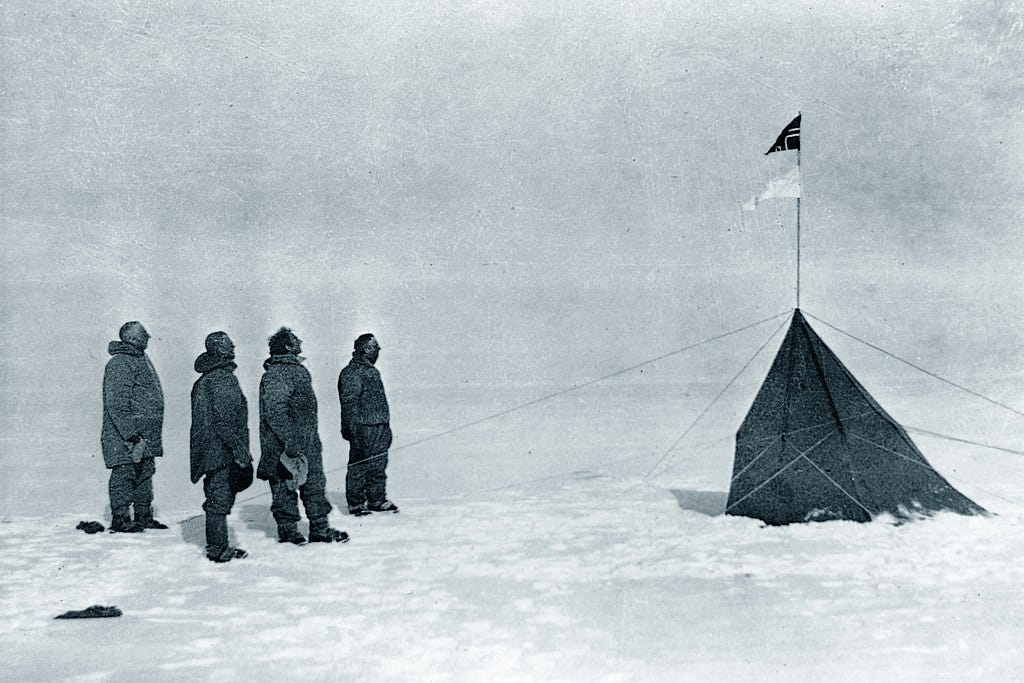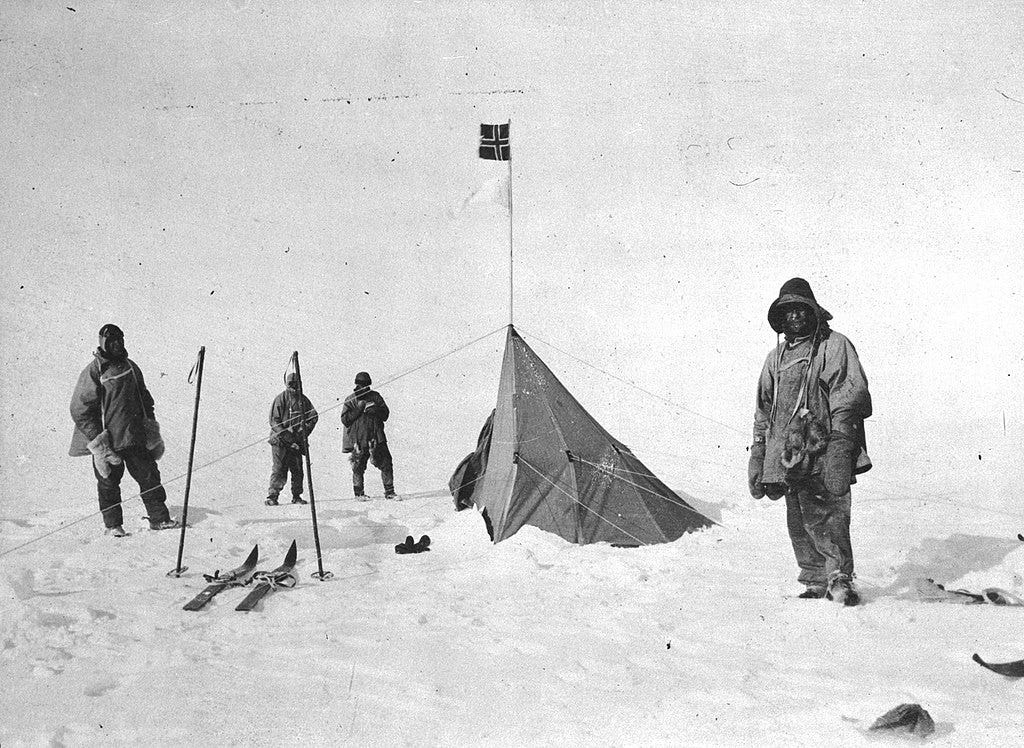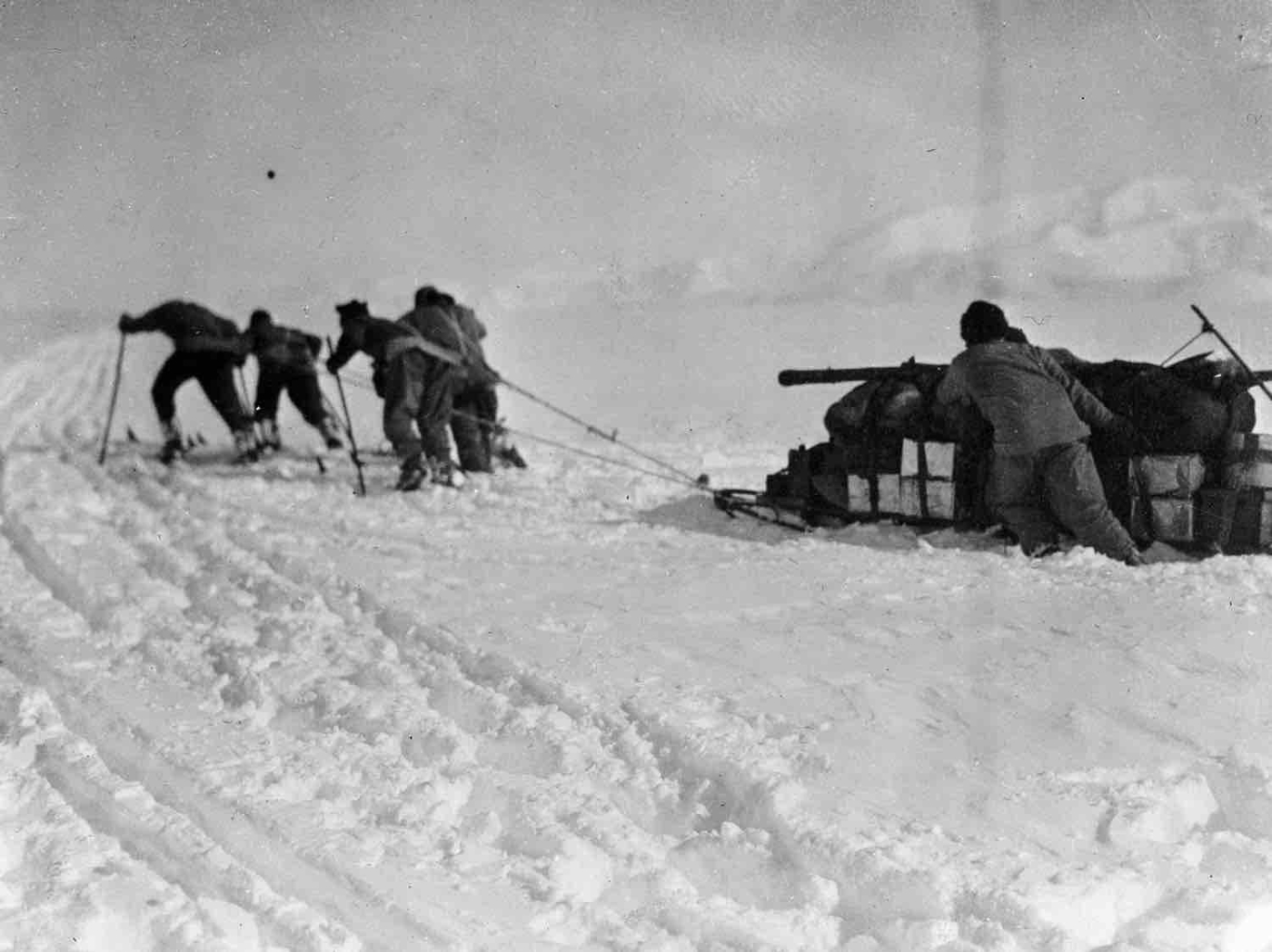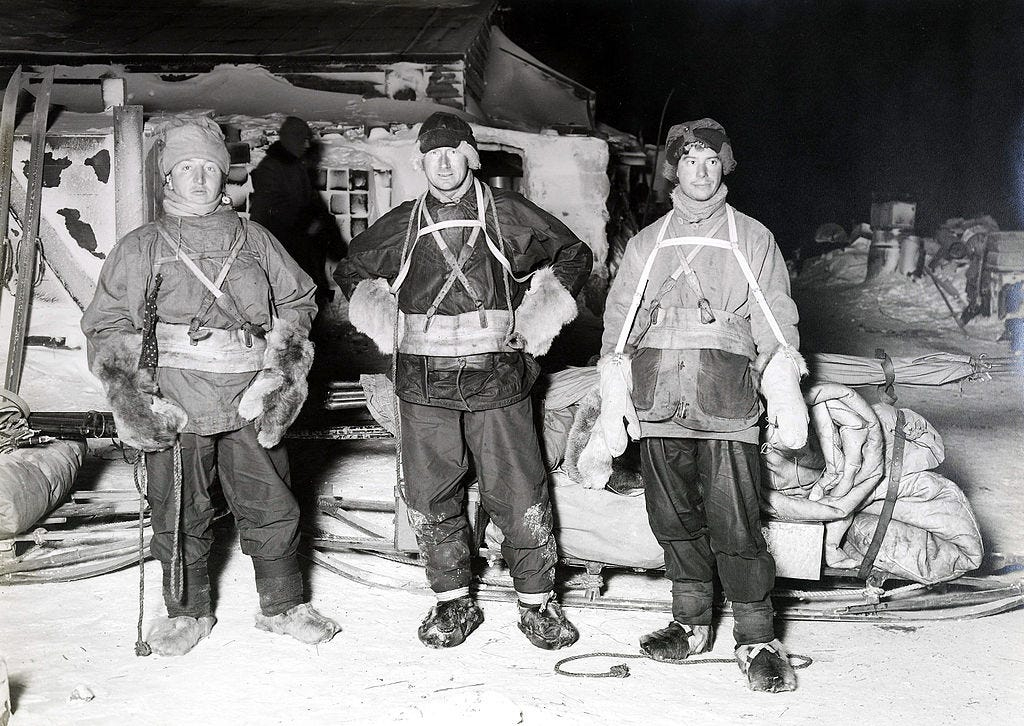
In startups, speed reduces risk.
In many ways, this is deeply, deeply counterintuitive. It goes against the physical intuition we've all acquired from youthful scraped knees and twisted ankles. It goes against the conventional wisdom drummed into us at school. It goes against the operating principles beloved of large organizations—diversify your efforts, hedge all risks, operate redundantly, work to a cadence.
These principles don’t apply to early-stage companies. They’re not just irrelevant, they’re anti-patterns that will actively hurt founders’ efforts. Speed is the single best way to de-risk a startup. Many people in tech know this in theory, but truly believing and acting on it is much harder.
To help remind you of this lesson, let’s peek into the annals of history—namely, the race to the South Pole in the early 1900’s. It’s a tale of two polar expedition parties, one focused on speed and the other on caution. As you might expect, one story ends in victory, and the other in tragedy. Consider it an apt analogy.
The worst journey in the world
In 1911, two different parties set out to reach the South Pole. One was led by British Royal Navy officer Robert Falcon Scott. He believed there was safety in numbers: that a large, slow-moving convoy faced fewer risks than a small and agile team.
He thought the success of such a convoy depended on perfect adherence to complex plans, often written down weeks or months in advance. He enforced strict Naval discipline and a rigid hierarchy, to ensure there were no deviations from these plans.
When conditions on the ground belied his assumptions, he refused to change. When things went wrong, as they inevitably did, Scott struggled to course correct.
It didn’t help that Scott’s party had taken on many scientific goals for their journey, beyond being first to the South Pole. They tried to study and document various environmental factors. They hauled pounds of specimens, like rocks, extracted from the landscape. They experimented with new transport approaches, like ponies and motorized sledges (a type of sleigh).
In short, they did too much and it slowed them down.
As things went wrong, Scott’s team had to contend with constant gnawing hunger, cold and thirst, going on short rations and running out of fuel while performing prodigious amounts of work. His party suffered terribly from deficiency disease, injuries (one person’s leg and another’s hand rendered them unable to work or even walk sometimes), snow blindness, frostbite, gangrene and more.
In the end, Scott and his polar party paid the price for his rigidity. The four men who made the final leg of the trek all died, despite a rescue attempt staged by those who remained at base camp.
Caption: Man-hauling in the Antarctic
Shaving down the skis, and other details of success
In striking contrast, Scott's great rival—the Norwegian explorer Roald Amundsen—succeeded with comparative ease (mere weeks apart!). Every aspect of his strategy—equipment, transport, and personnel—was optimized for speed.
Over the winter before the polar dash, Amundsen's team laboriously reviewed every single piece of gear they’d carry, with the sole goal of saving time. They shaved down the skis to save a few ounces of weight. They unpacked their bulk rations and repacked it into daily allowances. They sewed two tents together to halve their setup time. They designed storage canisters that could be opened without unlashing them from the sledges.
Amundsen traveled with a small group, knowing they’d travel lighter and move faster. To make up for lack of numbers, everyone picked had multiple specialties. Olav Bjaaland was a national ski champion who was also a highly skilled carpenter. Helmer Hanssen was both a superb navigator and experienced dog handler. Sverre Hassel was a qualified ship's mate, navigator, sail-maker and leather-worker.
Most importantly, having assembled this team Amundsen gave them wide discretion to act independently. Again, this was in the service of speed, but it also helped with adaptability to unforeseen circumstances.
While Scott's 12-man summit party laboriously dragged 1000 kg of food and supplies up a 10,000 ft glacier on sticky wooden sledges, Amundsen's party used skis and dogsleds and didn't have to man-haul once.
Lastly, Amundsen focused them on a single goal: to get to the Pole and back as quickly as possible. He was happy to take tactical risks to serve this strategy. For instance, both his base and his route were on uncharted (and hence dangerous) territory. They were chosen because they shortened his journey by hundreds of miles; he correctly judged that this was the lesser risk.
Similarly, Amundsen didn't mind skiing in fog or snow or even a moderate blizzard; he determined it was less risky than staying put. (It’s worth noting that he resisted the temptation to ski for more than six hours on any given day. He didn't want to overtire his team.)
Above all, he was flexible: unafraid to change his plans, but fully committed to whatever plan was currently in place.
It will be a wearisome return

Caption: Scott’s polar party, despondent to see the Norwegian flag
Facing the same conditions, with far fewer resources, Amundsen outdid Scott on every measure. Amundsen’s team made it to the South Pole first—by mere weeks!—planting the Norwegian flag. From Scott’s diary:
“This told us the whole story. The Norwegians have forestalled us and are first at the Pole. It is a terrible disappointment, and I am very sorry for my loyal companions. Many thoughts come and much discussion have we had. To-morrow we must march on to the Pole and then hasten home with all the speed we can compass. All the day dreams must go; it will be a wearisome return.”
Amundsen's polar party covered 3440 km in 99 days — with effort, yes, but no real suffering. Scott's party covered 3200 km in 148 days with injury, travail and death. Scott writes of the Pole, “Good God! this is an awful place.” Whereas Amundsen's companions write, variously: “the dogs are enjoying life” ... “it'll be fun, the finish to this race” ... “the most wonderful conditions” .... “splendid.”
Amundsen and his companions actually gained weight on their journey. In his journal, Amundsen describes feasting on seal meat and biscuits: “we are living in the fleshpots.” The worst physical affliction to befall his party was a toothache.
Scott, on the other hand, lost not only his race to be first at the pole, but also his life, and the lives of the four men he made the final leg of the journey with (the others were left back at base camp). After reaching the pole, his party was starving and exhausted, stricken by injury, frostbite and scurvy. On the return trip, they died slowly, one by one. Oates, a man who was particularly weak and thus a “hindrance” to the team, chose to wander out into a blizzard in an apparent suicide. Scott described it in his diary as “the act of a brave man and an English gentleman.”
Because of bad weather and depleted rations, one of the relief teams searching for them was forced to turn back — just a few miles away from the tent where (unknownst to them) Scott and his companions lay helpless and dying.
Risks increase super-linearly with time
Why did Amundsen succeed where Scott failed? Ultimately, Amundsen prioritized one big factor that Scott didn't. In polar exploration, moving fast reduces your risk.
In most fields of human experience, this is emphatically not true. Driving fast is riskier than driving slowly. Structures built quickly tend to be less stable. Work performed rapidly tends to be sloppy. Crash diets aren't as effective as lifestyle changes. Slow and steady wins the race; short cuts lead to long delays; haste makes waste; and so on. This is the calculus that most of us have internalized, and it usually works.
But not in Antarctica. Humans cannot survive unassisted on the Polar Plateau. It’s too cold; the air is too thin; there's no source of food or fuel or drinkable water. When your supplies run out, you die.
That's bad enough if you're staying at a base camp, but at least you can hunker down and wait for ships from New Zealand or Argentina or Australia to re-supply or rescue you. The situation is much worse if you plan to leave your base and journey into the unknown.
You have to carry all your resources with you, for as long as you’ll be away from base. You’re pioneering a route into the unknown, and you don't know what obstacles will arise in your path: unclimbable mountains, treacherous crevasses, impassable ‘pressure ice.’ You don’t know what weather to expect: blizzards that last for days, or snow-glare that renders you blind. You don't know how long your journey will take, or how your team will deal with conditions nobody has ever encountered before.
And those are just the known unknowns! The longer you spend, the more vulnerable you become to unknown unknowns. Accidents become death sentences. But so do seemingly trivial incidents: a leaky oil stopper, for instance, or a misplaced glove. Or simple ignorance — most notably, of the role of fresh food in preventing scurvy.
This is what Amundsen realized, and Scott did not. The risks of failure — from exhaustion, starvation, injury, illness, accident, mishap, ignorance — increase super-linearly with time.
So the correct, risk-averse thing to do is to spend as little time as possible on the journey.
Caption: Members of Scott's previous Antarctica expedition
A day late, a dollar short, a startup gone
Of course, gentle reader, this essay is not about polar exploration at all; it’s about technology startups. Tech startups, like Scott and Amundsen, operate in conditions that are unknown, and unforgiving. (Note: I’m referring to startups at the sub-100 employee size. When you’re at the scale of a Facebook or Google, you have a different level of responsibility and impact, and caution is more rightfully required.)
Unknown: Early stage founders have to discover almost everything about their business. What is the product? Who is the customer? How do we reach them? What will they pay? How do we hire, and scale, and compete, and disrupt, and defend? It's like putting together a jigsaw puzzle where you have to craft each piece from scratch and you don't know what picture you're assembling.
Unforgiving: Early stage founders need to hire, build, sell and grow, before they run out of cash. It's a race against the clock, and most startups are ‘default dead’—their runway will end before they reach profitability. This is like venturing on the Polar Plateau: you have to reach safety or perish. Time is not your friend. (The jigsaw puzzle will explode if you don't finish it in six months.)
What's the best way to mitigate this deadly duo? Amundsen knew the answer. Speed. Through what specific mechanisms does speed reduce startup risk?
Speed is a competitive advantage in itself. In fact, it’s the only sustainable advantage that startups have. Startups are famously under-resourced compared to big companies; they lack money, brand, people, scale, reach, robustness and pretty much everything else. The one thing that startups can do better than incumbents is move fast. In dynamic environments (shifting macro trends, rapidly evolving technology, demanding customers, ruthless competition), this alone might suffice to win the market!
Speed gives you more shots at your goal. This is the big one. When you have to discover everything, it helps to have lots of chances at discovery. Each shot doesn’t have to be perfect; in fact it’s best if they’re not: perfect is the enemy of good enough. But you can learn a lot from “good enough.”
Speed hedges against burnout. Why do startups fail? Superficially, they fail when they run out of money. But fundamentally, startups fail when their founders lose faith. And the single most common reason for this loss of faith is burnout: pushing that boulder endlessly up the hill. Slow and steady magnifies this feeling; it’s hard to feel energized when every day is a slog.
I believe you, truly I do. (No I don’t.)
Let's go through a list of startup cliches, shall we?
- Move fast and break things: because slowing down is riskier than making mistakes.
- Do things that don't scale: because building for scale wastes time that you don’t have.
- Strong opinions, weakly held: because hedging your bets slows you down.
- Two-pizza teams: because beyond a certain minimal size, additional hires also slow you down.
- Hire for slope not intercept: because the best predictor of future velocity is past velocity.
- Make the main thing the main thing: because focus creates alignment and alignment fosters speed.
- Find your North Star: because measuring what matters is the best way to not get hung up on irrelevancies.
Almost everybody in the startup ecosystem agrees that speed is a good thing. Almost nobody acts like it.
We’ve been socialized to believe that going too fast is risky. We fear launching too soon; we abhor looking sloppy; we shy away from criticism; we look for side-quests; we think “one more feature” will save us; we bike-shed. All these tendencies slow us down, but we think they reduce our chance of failure, and more importantly, the appearance of failure.
We forget that for startups, not going fast is riskier still. This essay was written to tell you, gentle startup founder, that in the beginning it’s okay to go faster than comfort dictates; faster than feels prudent; faster than you think you can. In fact, it’s not just okay; it’s optimal.
When you’re struggling with this, remember the tale of the two polar explorers and take their lessons to heart.
Author bio: Abraham Thomas is an angel investor based in Toronto; he was previously the co-founder of Quandl, a successful venture-backed tech startup. Abraham writes occasional essays on data, investing, and startups via his substack Pivotal.
Find Out What
Comes Next in Tech.
Start your free trial.
New ideas to help you build the future—in your inbox, every day. Trusted by over 75,000 readers.
SubscribeAlready have an account? Sign in
What's included?
-
Unlimited access to our daily essays by Dan Shipper, Evan Armstrong, and a roster of the best tech writers on the internet
-
Full access to an archive of hundreds of in-depth articles
-
-
Priority access and subscriber-only discounts to courses, events, and more
-
Ad-free experience
-
Access to our Discord community


Comments
Don't have an account? Sign up!